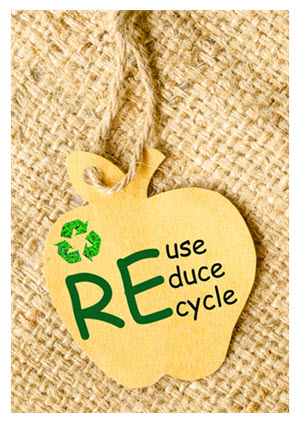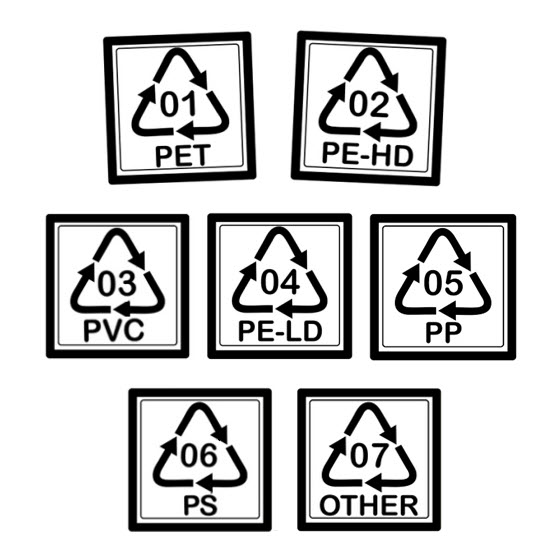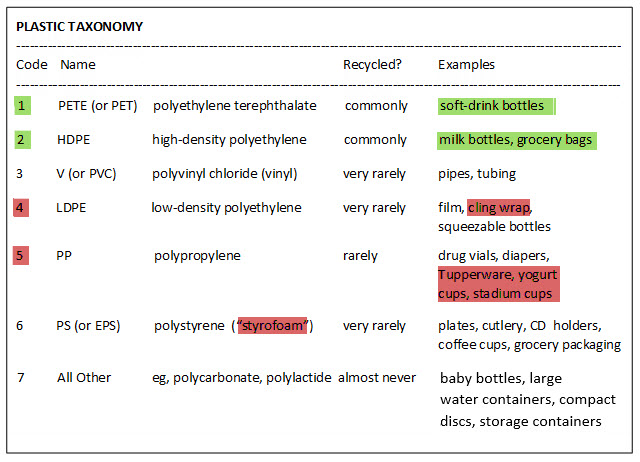It was a light bulb moment, or rather, a rapid fire series of them as I recognized that my recycling habits, albeit well meaning, were woefully uninformed. If you’re anything like me, you will welcome a handful of recycling tips in order to live a healthier life, reduce waste, conserve natural resources, and save money while you’re at it!
 The basics of reducing, reusing, and recycling?
The basics of reducing, reusing, and recycling?
Not only are these concepts easy to understand, but when we alter our habits even slightly, we have a nice little reason for a bit of chest-puffery. We’re being kind to the environment!
While I am not an expert on the subject of recycling, a bit of research combined with input from those in the know can go a long way to being kinder to Mother Earth. And that naturally results in kindness to ourselves and our families.
Why Recycle?
Why recycle — properly?
Try this:
- Save energy
- Conserve natural resources
- Reduce landfill and toxic waste
- Be healthier!
- Become a planetary superhero!
If you’re wondering what I include in a conversation on recycling, let me say that I consider a number of integrated issues to be a matter of lifestyle. And that lifestyle is all about living with greater attentiveness to consumption and disposal habits, and thus the use of the phrase “reduce, reuse, recycle.”
 My perspective is reframed when I read this, as excerpted from Treehugger.com:
My perspective is reframed when I read this, as excerpted from Treehugger.com:
Reducing the amount that we consume, and shifting our consumption to well-designed products and services, is the first step. Finding constructive uses for “waste” materials is next. If it’s broken, fix it don’t replace it! … Tossing it in the blue bin should be last.
Got that?
- Reduce consumption / shift to better designed products & services
- Reuse / repurpose everything you can! (Besides, it can be fun)
- Blue bin for recycling, with other options for goods that are “non-recyclables”
My Light Bulb (Recycling) Moment
I can thank my sons as preteens and adolescents — my younger son in particular — for insisting that our household do its bit for recycling.
“Mom, we need to recycle,” my kiddo said. “Get a recycle bin.”
“I know. You’re right. We do. I will.”
I can only imagine this to be my robotic response while standing at the sink, or languishing over my laptop, or brooding over bills at the kitchen table. However…
One determined child + One weary mother = eventual understanding and action
In other words, delivery of a Big Blue Bin from the city with which to recycle!
What followed was a modest amount of embarrassment that I waited so long, and only recently, recognition that my diligent attention to what’s called single stream recycling — a system by which processing centers and machinery sort recyclables so the consumer doesn’t need to — hasn’t been accomplished as effectively as I thought. In other words, I made faulty albeit common assumptions.
But the recycle bin is the last step, remember? So let’s back up for a moment to those product and services again.
My Light Bulb (LIGHT BULB) Moment
Cue the same child, now a lanky college student, home on a break and organizing my unruly closets.
“Mom,” he says, exasperated. “What are you doing with all these old style bulbs?”
 Uh-oh. Adolescent consternation… dead ahead!
Uh-oh. Adolescent consternation… dead ahead!
Picture one middle-aged mother rolling her eyes and wondering why she agreed to let aforementioned offspring undertake this project… He’s rummaging around in the bottom of the pantry, stacking and sorting, then pointing out at least two dozen small boxes of various wattage traditional bulbs. And to be clear, no, these are not the energy efficient sort.
“Why don’t you use the new kind?” he asks.
And I find myself posing the very same question, only rephrased slightly: Why wouldn’t I switch to eco-friendly bulbs, especially as they save on energy cost and last longer?
Among the benefits of energy-efficient lighting in terms of dollars and environment:
… CFLs [Compact Fluorescent Lights] use 1/3 the electricity and last up to 10 times as long as incandescents. [Replacing] a single 18 watt CFL used in place of a 75 watt incandescent… equates to a $45 savings.
… Replacing a single incandescent bulb with a CFL will keep a half-ton of CO2 out of the atmosphere over the life of the bulb. If everyone in the U.S. used energy-efficient lighting, we could retire 90 average size power plants…
And this is only one example of making product choices that are economical for consumers and far better for the environment. Shouldn’t we look for organic / green household products to replace those “standbys” that may just be a matter of purchasing habit?
See this light comparison chart for more details on incandescents, CFLs, and LEDs.
Know Your Plastics!
You know those little numbers that appear inside the recycling triangle, stamped into the bottom of a cup or container? Not sure? Join the crowd. They’re so tiny and hard to read that we may never have paid attention.
As I’ve discovered the meaning of these digits and letters, now I’m concerned I’ve been tossing plastic into my recycling that Does. Not. Belong.
The Society of the Plastics Industry (SPI) uses a classification system that I never understood, and I confess, barely noticed. Numbers 1 through 7 are part of a coding scheme based on the chemical composition of the type of plastic, and these designations are critical to how and where plastics can be recycled.
Here’s the gist of the list:
- Thumbs up! In general, anything that is a number 1 or 2 can be recycled in your blue bin.
- Thumbs down… Many commonly used items that we “take out” or use “in” are NOT numbers 1 or 2!
Take a look at this to understand. (I have highlighted in green for the readily recycled 1s and 2s; I highlighted in red for those 4s, 5s, and 6s that I mistakenly thought were single stream recyclable.)
Want more detail? This is an excellent guide on commonly used plastic objects with illustrations to make it even easier.
City Recycling Guidelines Vary
Items we can place in the recycle bin and those we cannot are generally explained in city / town lists online, organized and presented in varying ways. I visited 20+ sites, and all offer friendly formats and understandable language.
 I am including select city guidelines here to get you started, and encourage you to check out recycling rules in your area.
I am including select city guidelines here to get you started, and encourage you to check out recycling rules in your area.
- Atlanta (GA) Recycling
- Austin (TX) Recycling
- Boston (MA) Recycling
- Cleveland (OH) Recycling
- Fairfax (VA) Recycling
- Juneau (AK) Recycling
- Minneapolis (MN) Recycling
- Montréal (QC) Recycling
- Phoenix (AZ) Recycling
- San Francisco (CA) Recycling
- Seattle (WA) Recycling
- Toronto (ON) Recycling
- Vancouver (BC) Recycling
Recycling Basics: It’s a Lifestyle!
Let’s keep it simple to start! Even some recycling is helpful, and we can ease into more as we grow accustomed to a gentle shift in habits. Meanwhile, here is my personal cheat sheet:
- Reuse plastic and glass jars and containers. Reuse store shopping bags; use canvas bags for groceries. (It’s chic, and very Euro besides.)
- YES for Big Blue Bin curbside recycling generally speaking: YES to newspapers, glass bottles and jars, office paper, junk mail, aluminum cans
- NO for Big Blue Bin curbside recycling generally speaking: NO to paper towels or tissues, plastic bags, wires including wire hangers, light bulbs, batteries, electronics, household cleaner containers*, polystyrene (also known as styrofoam)
- Aluminum can tabs and tops to bottles and jars can go into the recycle bin — as long as they are affixed back on their containers. (Loose tabs / tops cannot; for more detail see this source on caps, lids, and tops.)
- As mentioned yesterday, you may have access to recycling providers that will surprise you; for example, Whole Foods recycles Brita water filters, batteries, and all #5 plastics, and do check out Preserve’s Gimme 5 program as well as Terracycle.
Suggestions? Examples? Updates?
 We consume constantly. We shed “disposables” thoughtlessly. We tend to think of environmental concerns as the purview of liberal politicians, investigative journalists, and impassioned activists who take on polluters and corporate Bad Guys. But I believe that we can all do our part. Moreover, it really isn’t hard.
We consume constantly. We shed “disposables” thoughtlessly. We tend to think of environmental concerns as the purview of liberal politicians, investigative journalists, and impassioned activists who take on polluters and corporate Bad Guys. But I believe that we can all do our part. Moreover, it really isn’t hard.
The recommendations provided above?
They’re wins all round. And they include spending our dollars wisely, purchasing healthier products and services, growing the demand for those healthier options, reusing and repurposing what we think we no longer need, expanding our environmental knowledge, and spreading the word.
Also recommended: Subscribe to social media feeds or follow hashtags that include #recycling, #sustainability, #ecology, and #environment. New information is always coming out, and social media makes it easy to stay informed.
I welcome your thoughts, discoveries, updates, and suggestions.
*Learn more about recycling of household cleaners here.
Be sure to check out this related article.
You May Also Enjoy



A word about fluorescent light bulbs, including compact ones (CFLs). Any fluorescent bulb contains mercury, which is an extreme environmental and personal toxin. Individuals vary greatly in their ability to rid themselves of mercury – some can eliminate most of it that they come in contact with, some retain most of it, and suffer major debilitations for which they never find the cause.
As long as a fluorescent bulb remains intact the mercury remains inside, but should one hit the floor and shatter or be broken in the fixture, the human exposure is instantaneous and largely irreversible. Yes, I know many of us have disposed of fluorescent tubes by smashing them into smaller bits and lived to tell about it, but many of us also have a variety of unexplained ailments, especially as we get older.
Fluorescents are also not particularly environmentally friendly anymore. They formerly offered an improvement in power consumption over incandescents, but they were always a stopgap until something better came along, and LED bulbs are now largely taking over their place, especially as they come down in price. Since many of the U.S. power plants are coal fired ones which unfortunately emit mercury as a by-product, reduction of electricity consumption by using a newer technology provides benefits on two fronts.
If anyone is inclined to scoff at the effects of mercury, I would highly recommend Googling “mechanisms-by-which-mercury-causes-over-30-chronic-health-conditions”. A quick glance over this long paper will likely convince you that this is indeed “real”.
Thank you for another great comment, Robert. And an excellent reminder to read, ask questions and consider the pros and cons of our choices.
As to LEDs, the referenced (linked) site also goes into their advantages. (I struggled to keep this post short enough so as not to overwhelm, but inevitably, there’s so much more to say / learn / explore.)
I have however added this light comparison chart in the article body for more details on incandescents, CFLs, and LEDs. It includes references to mercury toxicity.
Thanks for sharing your cheat sheet. I am also using reusing jars and containers for storing foods and little materials. I believe that we can still find the worth of something by finding another purpose for it. Recycling is a very fun thing to do.